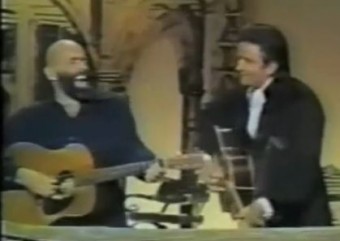The Johnny Cash Song “A Boy Named Sue” was Written by Shel Silverstein
Today I found out the Johnny Cash song “A Boy Named Sue” was written by Shel Silverstein.
The song was originally inspired by a friend of Silverstein’s, Jean Shepherd (noted writer, actor, radio personality, and humorist, who, among other things, co-wrote and narrated the holiday classic The Christmas Story film, partially based on his childhood). Jean had often been teased and picked on as a child for his somewhat effeminate name and was quoted as saying because of it, “I fist-fought my way through every grade in school.”
As to why Silverstein picked “Sue”, it is thought that it was after famed attorney Sue Hicks (named after Hicks’ mother who died from complications due to child birth a few days after giving birth to Hicks). Hicks is most famous for his part in the 1925 Scopes Trial (John T. Scopes was a teacher in Tennessee who broke Tennessee State law by teaching evolution in his classroom).
In any event, at a party in 1969 held at Johnny Cash’s home, some of the guests decided to pass a guitar around and sing some of their songs. Among those in attendance were Joni Mitchell, Bob Dylan, and, of course, Shel Silverstein. Mitchell sang “Both Sides Now” and Dylan sang “Lay Lady Lay” (what a party to be invited to). When it was Silverstein’s turn, he sang “A Boy Named Sue”.
Cash was enamored with the song and so Silverstein wrote the lyrics down for him. Cash’ wife, June, told him he should record the song in the upcoming show he was doing at the San Quentin prison on February 24, 1969.
Cash was at first resistant to recording it at the show, as he didn’t think he’d have time to learn it… and, indeed, he didn’t, but recorded it anyway. As Cash said,
I’d only sung it the first time the night before and I read it off as I sang it. I still didn’t know the words. As a last resort, I pulled those lyrics out and laid them on the music stand, and when it came time that I thought I was brave enough, I did the song.
In fact, if you watch the filmed recording of him performing “A Boy Named Sue” during that concert, you can see Cash is reading the lyrics as he sings, almost for the entire song.
As he really liked “A Boy Named Sue” and the inmates had responded well to it, Cash convinced Columbia Records, after cleaning up the lyrics a bit to be more radio friendly, to release the song as a single.
Up to this point, Cash had previously seen quite a bit of success, but had never had a record crack the top 10 in the Billboard’s Hot 100 (in fact, Cash still holds the record for most consecutive songs that charted on the Top 100 without cracking the top 10- at 36 songs). “A Boy Named Sue” changed all that, rocketing to #2 on the Hot 100 list and staying there for 3 weeks. It also hit #1 on the U.S. Billboard’s Hot Country Singles.
Bonus Facts:
- There is a sequel of sorts to “A Boy Named Sue”, written by Shel Silverstein from the perspective of the father of Sue, called “The Father of a Boy Named Sue”. You can listen to it here: The Father of a Boy Named Sue
- While Shel Silverstein is today best known for his children’s poem books such as “Where the Sidewalk Ends”, before that he was a noted song writer and longtime writer/cartoonist for Playboy magazine (from 1957 through much of the 1970s.) Silverstein got his start as a somewhat professional cartoonist when he was drafted into the army in 1953 and was published in the Pacific Stars and Stripes. After the war, he got a job as a hot dog seller, primarily working Cubs and White Sox games. During this time, he also continued to submit his cartoons to various magazines and his career blossomed from there.
- Besides “A Boy Named Sue”, Silverstein wrote Johnny Cash’s “25 Minutes to Go”. Other popular songs written by Silverstein included: Tompall Glaser’s “Put Another Log on the Fire”; Loretta Lynn’s “One’s on the way”; Irish Rovers’ “The Unicorn”; Dr. Hook’s “The Cover of the Rolling Stone” and “Freakin’ at the Freakers’ Ball”; Bobby Bare’s “Tequila Sheila”; and many, many others. For his various hit songs, he was inducted into the Nashville Songwriters Hall of Fame in 2002 (three years after his death). He also won a Grammy in 1970 for “A Boy Named Sue” and was nominated for a Golden Globe and Academy Award for the song “I’m Checkin’ Out”, which was featured on the movie “Postcards from the Edge”.
- Silverstein started drawing and writing at a very young age, “When I was a kid—12 to 14, around there—I would much rather have been a good baseball player or a hit with the girls, but I couldn’t play ball. I couldn’t dance. Luckily, the girls didn’t want me. Not much I could do about that. So I started to draw and to write. I was also lucky that I didn’t have anybody to copy, be impressed by. I had developed my own style; I was creating before I knew there was a Thurber, a Benchley, a Price and a Steinberg. I never saw their work till I was around 30. By the time I got to where I was attracting girls, I was already into work, and it was more important to me. Not that I wouldn’t rather make love, but the work has become a habit.”
- The practice of passing a guitar around each person singing a song is known as a “guitar pull”.
| Share the Knowledge! |
|






One comment